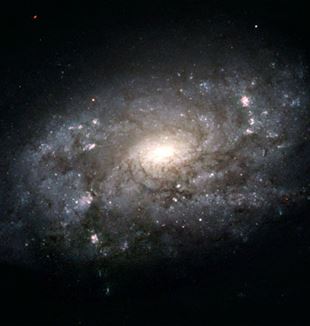
News From Space
The first findings of the mission exploring the origins of the universe have been published. This journey, begun in 1992, involves scientists from all over the world. We asked one of them to tell us about the "goldmine of new facts" they are discoveringThe January 11th press conferences in Rome, Paris, Copenhagen, and Seattle, presented the first results of the Planck space mission, published in detail in a series of articles in Astronomy and Astrophysics. These are the new findings from the first year of the mission, completed on May 14th, during which Planck uninterruptedly probed the sky in all directions.
The eye of Planck is made to see where our eyes see the dense darkness of the background of the sky. Since it was placed in orbit on May 11, 2009 (near Lagrangiano point L2, 1.5 million kilometers from Earth), the European satellite has been producing a high definition map of the celestial vault with wavelengths of a few millimeters, where the sky bears the tangible signs of its ancient past. The instruments of Planck record the very weak diffused glow (called Cosmic Microwave Background Radiation) from the furthest accessible horizon of the universe, light that has traveled for the entire history of the universe, bringing with it an image of the newborn cosmos. Planck is producing an image of it with unprecedented precision. In the uniform fabric of primordial light there are faint irregularities or "anisotropies" (we could compare them to ripples of a few millimeters on the surface of a 100-meter deep lake), that correspond to the fluctuations of density in the unformed fiery cosmos of 14 billion years ago: they are, so to speak, the initial "seeds" from which the galaxies, stars, and all the structures we observe in today's universe germinated. In the statistics of the anisotropies are encoded the values of the parameters that describe the composition, geometry, and evolution of the universe, and the Planck instruments enable us to measure them with great accuracy and reliability.
This is the final goal, an objective (foreseen for 2013 or thereabouts), when all the data will have been collected and duly analyzed. But, just as during a hike to a mountain peak we often discover here and there marvelous and unexpected partial views, maybe in the vegetation or in the profile of the rocks near us, so as we go forward with the analysis, the Planck data offers us some splendid surprises, not about the remote universe, but the close universe, which leaves its mark in the data. Precisely these "local" marks will be the focus of attention in this first batch of results.
TRACES OF SEEDS.
In the first nineteen months of observation, Planck produced an initial version of a new cosmic map (see photographs on pages 42-43) obtained by combining the data collected from all 74 sensors at wavelengths between a centimeter and a third of a millimeter. Just as in a good panoramic photograph, we have here a foreground subject (the vegetation and the nearby rocks) and a background (the great mountain chain on the horizon). In the cosmic panorama of this image, the foreground is dominated by the Milky Way (the white-violet component, very intense on the horizontal plane) and other local sources, while in the distance one glimpses the primitive universe (the uniform reddish background)–this is the cosmic background of microwaves, in which one can make out the granular structure of the anisotropies, the trace of the primordial seeds.
In order to obtain the "clean" map of the cosmic background–the final objective of Planck–it is necessary to separate with precision the local contributions from the Milky Way and other sources that overlap the cosmic signal, confusing it. It requires very complex analyses, which are currently underway. This cleaning process of the data makes it possible to obtain, almost like a by-product, precious information on the "nearby" universe: it speaks to us, for example, of the birth of new stars in our galaxy, of the nature of the extragalactic sources, of the traces of the clusters of galaxies. These first fruits of Planck, collected in a vast catalogue (the Planck Early Release Compact Source Catalog) made available January 11th to the international scientific community, offer a goldmine of new facts to investigate.
These preliminary results are exciting and promising. As the acquisition proceeds, we see an increasingly clear image of the newborn universe emerge right before our eyes, with a heretofore-unseen refinement. It is a privilege to admire this spectacle, and even more so to be able to recount it. But, as any lover of the mountains knows well, the beauty of the panorama is in some way inseparable from the labor, the trepidation, even the aridity, in certain moments, of the ascent.
The beauty of the intermediate stage, just as of the view of the peak, is that both are a foretaste of a superior beauty.
* University of Milan,
Instrument Scientist of Planck-LFI.